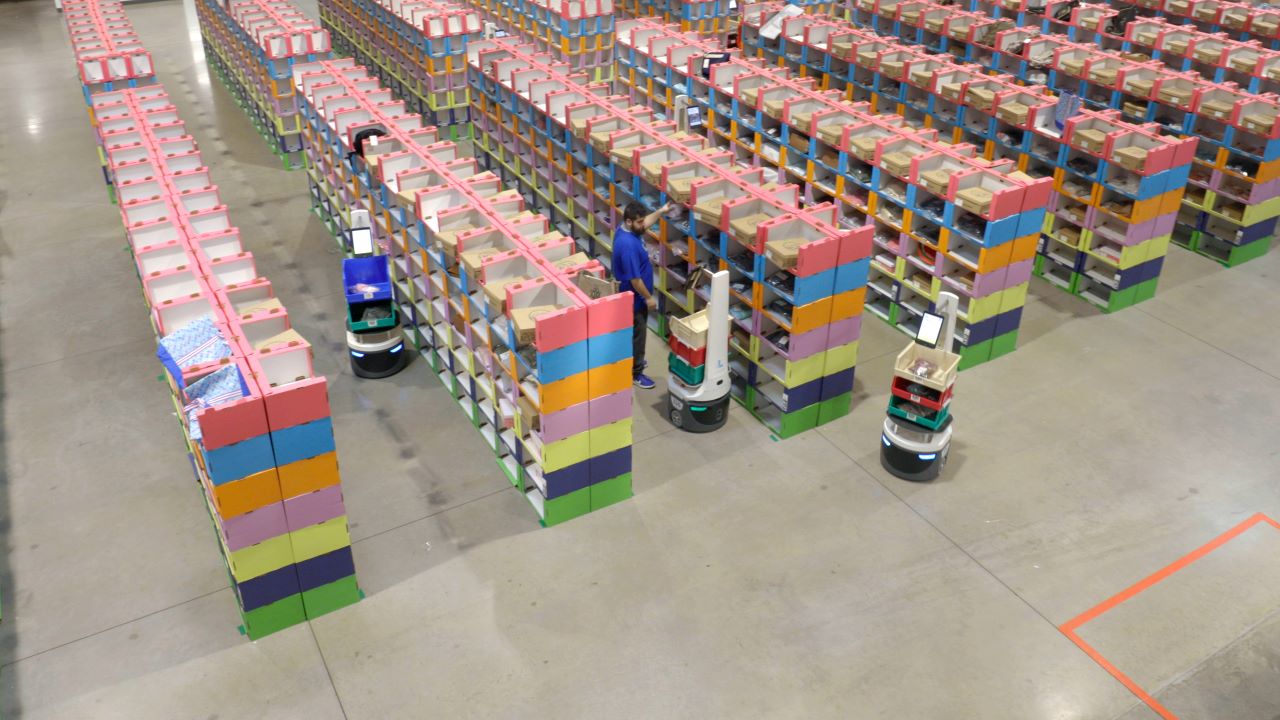Transform retail operations with Zebra’s retail technology solutions, featuring hardware and software for improving inventory management and empowering teams.
Streamline operations with Zebra’s healthcare technology solutions, featuring hardware and software to improve staff collaboration and optimise workflows.
Enhance processes with Zebra’s manufacturing technology solutions, featuring hardware and software for automation, data analysis, and factory connectivity.
Zebra’s transportation and logistics technology solutions feature hardware and software for enhancing route planning, visibility, and automating processes.
Zebra's public sector technology solutions enhance decision-making, streamline operations, and safeguard communities with advanced software and rugged hardware.
Zebra's hospitality technology solutions equip your hotel and restaurant staff to deliver superior customer and guest service through inventory tracking and more.
Zebra's market-leading solutions and products improve customer satisfaction with a lower cost per interaction by keeping service representatives connected with colleagues, customers, management and the tools they use to satisfy customers across the supply chain.
Empower your field workers with purpose-driven mobile technology solutions to help them capture and share critical data in any environment.
Zebra's range of mobile computers equip your workforce with the devices they need from handhelds and tablets to wearables and vehicle-mounted computers.
Zebra's desktop, mobile, industrial, and portable printers for barcode labels, receipts, RFID tags and cards give you smarter ways to track and manage assets.
Zebra's 1D and 2D corded and cordless barcode scanners anticipate any scanning challenge in a variety of environments, whether retail, healthcare, T&L or manufacturing.
Zebra's extensive range of RAIN RFID readers, antennas, and printers give you consistent and accurate tracking.
Choose Zebra's reliable barcode, RFID and card supplies carefully selected to ensure high performance, print quality, durability and readability.
Zebra's rugged tablets and 2-in-1 laptops are thin and lightweight, yet rugged to work wherever you do on familiar and easy-to-use Windows or Android OS.
With Zebra's family of fixed industrial scanners and machine vision technologies, you can tailor your solutions to your environment and applications.
Zebra’s line of kiosks can meet any self-service or digital signage need, from checking prices and stock on an in-aisle store kiosk to fully-featured kiosks that can be deployed on the wall, counter, desktop or floor in a retail store, hotel, airport check-in gate, physician’s office, local government office and more.
Adapt to market shifts, enhance worker productivity and secure long-term growth with AMRs. Deploy, redeploy and optimize autonomous mobile robots with ease.
Discover Zebra’s range of accessories from chargers, communication cables to cases to help you customise your mobile device for optimal efficiency.
Zebra's environmental sensors monitor temperature-sensitive products, offering data insights on environmental conditions across industry applications.
Zebra's location technologies provide real-time tracking for your organisation to better manage and optimise your critical assets and create more efficient workflows.
Enhance frontline operations with Zebra’s AI software solutions, which optimize workflows, streamline processes, and simplify tasks for improved business outcomes.
Empower your frontline with Zebra Companion AI, offering instant, tailored insights and support to streamline operations and enhance productivity.
The everything you need to rapidly and cost effectively develop high-performance AI vision applications on Zebra mobile computers.
Zebra Workcloud, enterprise software solutions boost efficiency, cut costs, improve inventory management, simplify communication and optimize resources.
Keep labour costs low, your talent happy and your organisation compliant. Create an agile operation that can navigate unexpected schedule changes and customer demand to drive sales, satisfy customers and improve your bottom line.
Drive successful enterprise collaboration with prioritized task notifications and improved communication capabilities for easier team collaboration.
Get full visibility of your inventory and automatically pinpoint leaks across all channels.
Reduce uncertainty when you anticipate market volatility. Predict, plan and stay agile to align inventory with shifting demand.
Drive down costs while driving up employee, security, and network performance with software designed to enhance Zebra's wireless infrastructure and mobile solutions.
Explore Zebra’s printer software to integrate, manage and monitor printers easily, maximising IT resources and minimising down time.
Make the most of every stage of your scanning journey from deployment to optimisation. Zebra's barcode scanner software lets you keep devices current and adapt them to your business needs for a stronger ROI across the full lifecycle.
RFID development, demonstration and production software and utilities help you build and manage your RFID deployments more efficiently.
RFID development, demonstration and production software and utilities help you build and manage your RFID deployments more efficiently.
Zebra DNA is the industry’s broadest suite of enterprise software that delivers an ideal experience for all during the entire lifetime of every Zebra device.
Advance your digital transformation and execute your strategic plans with the help of the right location and tracking technology.
Boost warehouse and manufacturing operations with Symmetry, an AMR software for fleet management of Autonomous Mobile Robots and streamlined automation workflows.
The Zebra Aurora suite of machine vision software enables users to solve their track-and-trace, vision inspection and industrial automation needs.
Zebra Aurora Focus brings a new level of simplicity to controlling enterprise-wide manufacturing and logistics automation solutions. With this powerful interface, it’s easy to set up, deploy and run Zebra’s Fixed Industrial Scanners and Machine Vision Smart Cameras, eliminating the need for different tools and reducing training and deployment time.
Aurora Imaging Library™, formerly Matrox Imaging Library, machine-vision software development kit (SDK) has a deep collection of tools for image capture, processing, analysis, annotation, display, and archiving. Code-level customisation starts here.
Aurora Design Assistant™, formerly Matrox Design Assistant, integrated development environment (IDE) is a flowchart-based platform for building machine vision applications, with templates to speed up development and bring solutions online quicker.
Designed for experienced programmers proficient in vision applications, Aurora Vision Library provides the same sophisticated functionality as our Aurora Vision Studio software but presented in programming language.
Aurora Vision Studio, an image processing software for machine & computer vision engineers, allows quick creation, integration & monitoring of powerful OEM vision applications.
Adding innovative tech is critical to your success, but it can be complex and disruptive. Professional Services help you accelerate adoption, and maximise productivity without affecting your workflows, business processes and finances.
Zebra's Managed Service delivers worry-free device management to ensure ultimate uptime for your Zebra Mobile Computers and Printers via dedicated experts.
Find ways you can contact Zebra Technologies’ Support, including Email and Chat, ask a technical question or initiate a Repair Request.
Zebra's Circular Economy Program helps you manage today’s challenges and plan for tomorrow with smart solutions that are good for your budget and the environment.

3 Reasons Why the COVID-19 Pandemic Is Driving Greater Demand for Cobots
I have watched with interest as the robotics industry has enjoyed accelerated growth over the past couple of years. We saw around a 38% rise in robots used for professional services in 2020 and can expect to see a doubling of robots used in logistics between 2019 and 2021.[1] And the World Robotics 2020 Industrial Robots reports that 2.7 million industrial robots are currently operating in factories around the world. These numbers don’t account for the intelligent automation solutions that retailers are increasingly employing to improve operational visibility or the smart robotics solutions being put to work in warehouses to augment the human workforce.
Cobots Plug Resource Gaps during COVID-19
With consumers staying at home and ordering online during the pandemic, demand for warehouse workers skyrocketed. Unfortunately, those positions often went unfilled, and even facilities that hired pickers had to ensure safety and social distancing. This is where robots, and specifically cobots (robots that collaborate with people) started to prove extremely valuable. They were able to take some of the mundane task load off human workers to help drive productivity and meet customer demand. They also helped to offset labour losses by running picked items over to packers and automating processes that allowed workers to stay focused on getting orders out the door. In fact, the impact of robotics automation has been so impressive that other sectors have also started to embrace this technology on a greater scale.
Retailers are employing inventory counting robots so that associates can stay focused on replenishment, merchandising and sales. Healthcare providers are investing in medicine delivery robots. And multiple industries are using robots to disinfect facilities. Without a doubt, the adoption of robotics has accelerated across the board. As Zebra’s robotics automation expert Jim Lawton recently noted in a podcast interview, more companies are starting to realize the value of collaborative robots (cobots) in supporting both human workers and overall operational execution and increasing deployments as a result. ABI Research actually expects the yearly revenue for cobot arms alone will reach $11.8 billion USD by 2030, up from $711 million in 2019. When you factor in additional software-related revenues and end-of-arm tooling (EOAT) accessories, the anticipated value of the cobot ecosystem jumps to $24 billion by 2030, which is up from its $1 billion valuation in 2019.
Evolving Motivations for Cobots
Although much of the technology has been around for some time, improvements in sensors, software, collision avoidance and navigation technology has created believers.
The threat of COVID-19 to people and industries has also broken down many objections, and cobots have become a much more attractive option for those looking for ways to improve workflows without causing further disruption. Indeed, many robotics specialists who expressed fears over safety, privacy and job losses have been surprised at just how quickly this long-standing resistance has disappeared in the face of new fears around COVID-19.
But company motivation behind the investment in cobots has also changed. Rather than traditional objectives around cutting costs, the focus now is on gaining a competitive advantage, as identified by the McKinsey report.[3]
The short-term goals have been to:
1. Keep consumers and patients safe from cross-contamination with disinfecting robots. In March 2020, Chinese hospitals were reported to have ordered over 2,000 ultraviolet disinfection (UVD) units.
2. Provide for social distancing by using smart robots to take on simpler tasks and allow workers to spread out more.
3. Maintain business operations in the face of staff shortages.
Navigating the way through the pandemic has clearly been the immediate priority for many businesses. And for those that have chosen to invest in robotics automation solutions during this time are poised to realise a long-term benefit that is unlikely to disappear once the pandemic is over. They will retain operational advantages, such as increased productivity, while gaining the flexibility to scale as needed to expand capacity and meet growing customer demands at a lower operating cost point. Plus, many real-world deployments of robotics automation solutions such as cobots have proven just how seamlessly the technology can be integrated into existing workflows, so all of these actions can be taken without further disrupting operations.
Plus, with robotics-as-a-service (RaaS) on the rise, any risk around capital expenditure is reduced. Companies can see exactly how cobots will work in their businesses and the potential return on investment (ROI). If partnered with the right solution provider, it will also be easy to scale the solution to support new workflow modeling and process execution frameworks, all of which can further enhance the ROI. Plus, RaaS helps to alleviate any fears that your company is investing in a technology that will soon become outdated. It’s a win-win for everyone involved.
Don’t Miss the Window of Opportunity
As with any change, the window of opportunity won’t be around for long, and right now robotics are on the cusp of mass uptake.
Robotics automation OEMs need to take advantage of the growing demand quickly. Speed in the product development lifecycle is crucial to success, as is the delivery of high-quality products. Make sure you’re one of the first out the gates by partnering with an OEM supplier who can provide a full range of first-class components with financial and time-saving benefits to you.
Zebra provides leading-edge technologies such as scan engines, RFID readers and mobile printers that can easily be integrated into robotics solutions. If you’re looking for inspiration on new solutions that can benefit your customers or want to learn more about how Zebra’s extensive OEM product portfolio can help take time and development costs out of your product development cycles, download the robotics application brief for OEMs.

Richard Thompson
Richard Thompson is the Global Director of Sales for the OEM business within Zebra Technologies which in turn is part of Zebra’s Global Sales & Services organisation. Richard is responsible for the sales of key component technologies which Zebra manufactures and sells to a hugely diverse range of customers around the world who build these components into their own final products.
He has a team of 40 specialist sales and support people around the world.
Richard has worked in the IT & Telecommunications Industry for almost 30 years and has held sales, management and senior management rolls in a number of global organisations, including Elcom International, Symbol Technologies, Panasonic Computer Products, General Dynamics and Motorola Solutions. Prior to his current role within Zebra he ran the OEM Business with in EMEA and prior to that the Government and Public Sector business and the Mobile Carrier partners business for Zebra in the UK & Ireland. He has also sat on the board of several industry bodies and charities.
Richard is married with two children aged 16 and 19 and lives in Worcestershire, UK.
He is a keen advocate of diversity and collaboration in the workplace.
Zebra Developer Blog
Zebra Developer BlogZebra Developer Blog
Are you a Zebra Developer? Find more technical discussions on our Developer Portal blog.
Zebra Story Hub
Zebra Story HubZebra Story Hub
Looking for more expert insights? Visit the Zebra Story Hub for more interviews, news, and industry trend analysis.
Search the Blog
Search the BlogSearch the Blog
Use the below link to search all of our blog posts.
Most Recent
Legal Terms of Use Privacy Policy Supply Chain Transparency
ZEBRA and the stylized Zebra head are trademarks of Zebra Technologies Corp., registered in many jurisdictions worldwide. All other trademarks are the property of their respective owners. Note: Some content or images on zebra.com may have been generated in whole or in part by AI. ©2025 Zebra Technologies Corp. and/or its affiliates.




